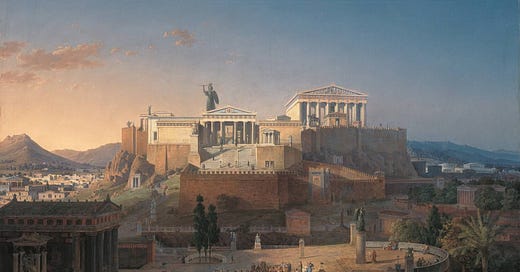Welcome to Cosmographia — a newsletter dedicated to exploring the world and our place in it. For the full map of posts, see here.
This is the second post in a short series about the origins of urban development.
Cities are now so ubiquitous we struggle to imagine a world without them. Most of us live and/or work in their sprawl. We are governed from the urban centre; they enforce our laws, manage our finances, produce most of the media, literature, and art we consume. Like dendritic cells, their tendrils spread spider-like into the rural hinterlands, extracting the food, energy, and minerals they need to sustain themselves and grow. The city is the human superorganism, a mass of teeming bodies from whose complex web of interactions something greater emerges.
Much of recorded history is simply the story of cities. Uruk gave us writing; democracy first emerged in Athens; Rome ruled Europe. Paper was invented in the city of Leiyang, the printing press in Mainz. Jews, Christians, and Muslims still revere Jerusalem. How did Alexander secure his conquests? By founding cities. When the great travellers of previous centuries embarked on their journeys into the perilous unknown, neither Marco Polo, Ibn Battuta, nor Zheng He were surprised to find cities strung across faraway lands. The Spanish conquistadors were amazed by much of what they found in Mexico and Peru, but not by the fact they should find great urban capitals in Cusco and Tenochtitlan, which despite a few superficial differences were largely like those back at home.
In our increasingly globalised, interconnected world, cities have only become more important, not less. International finance is conducted from London, Hong Kong, and Frankfurt. The world’s movies are directed from Los Angeles, Mumbai, and Lagos. The UN sits in New York, the WHO in Geneva, NATO in Brussels, the European Parliament in Strasbourg. Big Tech arose from San Francisco; the world’s best universities are found in Boston, Oxford, and Cambridge. The phone with which you read these words was manufactured in Zhengzhou or Gumi. The chip inside it was made in Hsinchu.
Homo sapiens are today an urban species. Approximately 58% of the world’s population currently lives in cities — a figure that’s expected to rise to 70% by 2050. Urbanisation seems inevitable, immutable, unstoppable. Over the last 6000 years cities have slowly but surely become our primary habitat. But it was not always so.
We first emerged among the African plains — a very different environment to the modern metropolis. Though the process of natural selection never stops,1 much of our biological hardware evolved to suit a habitat most of us have long left behind. So how is it that we are able to live in such a different space?






